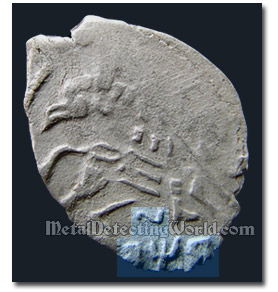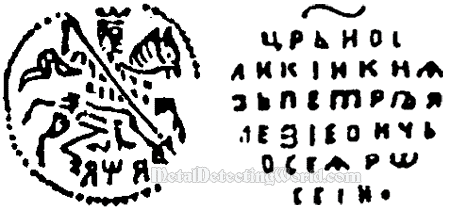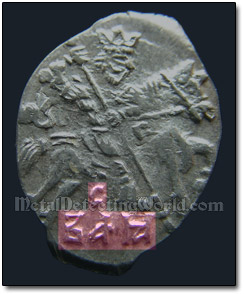How To Identify and Interpret Cyrillic Dates on Russian Coins of Peter I The Great:
Helpful Tutorial for Coin Collectors, page 1
Part 1: Cyrillic Numeral Dates and Their Varieties on Silver Wire Kopecks and Copper Coins

The silver wire kopecks of Peter I The Great look like the wire coins of previous Russian rulers; however, Peter's silver wire kopecks, issued after 1696, have a characteristic detail: they bear numeral dates expressed in old Cyrillic letters (see Table I: "System of Old Cyrillic Numerals" on page 2). Cyrillic numeral dates also appear on Peter's new coins (both silver and copper) minted mechanically between 1700 and 1722.
In 1700, the newly built coin mints in Moscow began producing round copper coins by machines. It was the first stage of Peter's monetary reform. Also the Julian calendar was put in effect in Russia on January 1, 1700.
Prior to 1700, the dates in Russia were expressed in years counted according to the old chronology called "from the Creation of the World". In order to accustom common people to the European chronology, the numeral dates on both the "old" wire kopecks and the "new" round coins of Peter The Great started to represent years counted from the "Nativity of Christ" (details are on page). The Cyrillic numeral dates were gradually abandoned in favor of Arabic numerals by 1723.
On silver wire kopecks, all numeral dates are located on the coin obverse and under the image of a horseman holding a spear ("копье" - "kopje", in Russian, hence the name "kopeck") as shown on a picture below. The numeral may consist from two to four letters depending on a year of mintage. Sometimes, the dates of the same year look different; thus, representing varieties.
Obverse and Reverse Images of 1701 1 Kopek, Peter I

Each date variety represents a mint and the mint engraver who could always choose one out of three variations of the same letter for the coin design, or change the order of last two Cyrillic letters in the 4-letter dates (more details on page 3). That is why there are usually from one to three varieties of each date. Exceptional are the dates 1701 and 1702 which have six varieties each.
The numerals on Peter I's silver wire kopecks should not be confused with another Cyrillic lettering - moneyers' marks and mint marks, which appears on wire coins of the pre-Peter I's periods.
Moneyer's Mark on Silver Wire 1554 1 Kopeck, Ivan IV

To distinguish between the numeral dates and the moneyers' and mint marks, the "titlo" sign (also "titla") accompanies the numerals on OBVERSES of the silver wire coins minted from 1696 to 1717, and on OBVERSES and REVERSES of "new" (round) coins minted from 1700 to 1722. This sign is located above the numeral date as shown on the first and second pictures above. According to a long-established practice, the "titlo" sign also was placed on REVERSES of the hammered wire kopecks of Peter The Great.
A Titlo Sign and Its Variations Appearing On Coins
![]()
* - the article will be posted upon its completion.